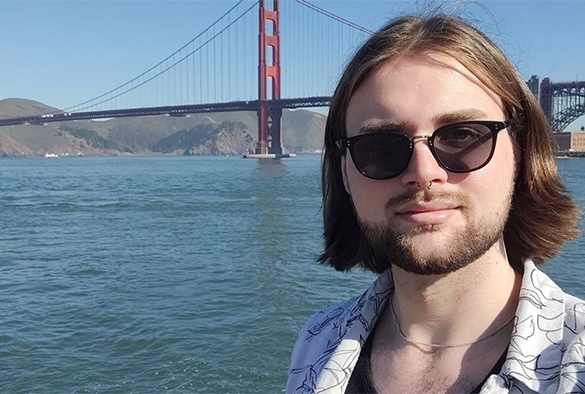Measuring light in California

It can be daunting to move to a new country. It can be even more daunting when the new country is America at the tail end of a global pandemic during a cost-of-living crisis. With my visa and suitcase over packed it was time to travel to University of California (UC), Davis, to work with Professor Robert Svoboda on Water based Liquid Scintillators (WbLS). My PhD work has been focused on the development of water Cherenkov detectors for neutrino measurements. Neutrinos are a fundamental particle that are hard to measure, due to having no charge and small interaction cross-section compared to other particles. Therefore, large detectors are needed to increase the probability of an interaction occurring that produces particles such as electrons that are directly measurable. Water Cherenkov detectors have dominated the field of neutrino physics until now due to the ease and safety of using water to fill large detector volumes.
From the interaction with a neutrino with an atom, the resulting Cherenkov light can be measured. Cherenkov light is special as it can tell us the original particle type, direction, position and energy which can give us an insight into the original nature of the neutrino. However, a downside to water-based detection is the Cherenkov limit which determines the lowest energy events we can measure. To lower the detection threshold, novel detection mediums are needed, one of which is WbLS. Liquid scintillators can amplify a low energy interaction as a small number of photons (particles of light) from an interaction are absorbed by the scintillator causing the excitation of an electron. When the electron returns to the ground state it emits more photons at a constant energy. These photons can then be absorbed by more scintillator molecules which then emit more photons until there is sufficient light for detection. The problem with this detection method is that the signal can become dominated with scintillation light which means the original particle type, direction, position and energy can’t be found. The development of WbLS then is to strike that fine balance between Cherenkov and scintillator light.
Part of this development is occurring at UC Davis and I was lucky enough to have the chance to work on its development. One of the projects I worked on at UC Davis was the development of nano-filtration of WbLS. Water quality can have a big impact on the systematic error of our measurement, so filters can be used to maintain the water quality of the detector. One issue with WbLS is that the micelles that make up the scintillators would be removed with standard filtration which is currently used to clean the water. A nano-filter will remove these micelles from the water so it can be further filtered before being recombined with them as it is circulated back into the detector. Without the development of this technology WbLS would be unusable for future neutrino detectors.
I was also involved in the development of the Scattering and Attenuation Measuring Device (SAMD). Attenuation measurements are more difficult than they first seem. To determine the reliability of our device water is used as a benchmark as it has widely been measured. Looking at past experiments it becomes clear how much variation can occur due to varying external factors. The time of day (light from the sun) and even nearby magnetic fields from cyclotrons can all affect the measurement. With so many uncertainties, my data analysis skills came in handy from collaboratively determining sources of error to using an orthogonal distance regression to fit to data to combat uncertainty in both the x and y measurements. By the end of my 6 months, we had successfully made attenuation measurements of water. Since being back in the UK a WbLS measurement has been made and I have been able to look at and analyse the data. These values for the attenuation of WbLS are now being fed back into our simulations. This is hugely important for us to be able to determine the capabilities of WbLS to improve future neutrino experiments.
- Adam Tarrant